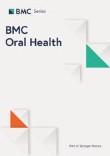
Abstract
Background
Children and adolescents with juvenile idiopathic arthritis (JIA) may suffer pain from temporomandibular disorder (TMD). Still, routines for the assessment of temporomandibular joint (TMJ) pain in health and dental care are lacking. The aims of this study were to examine the prevalence of TMD in children and adolescents with JIA compared to their healthy peers and to investigate potential associations between JIA and TMD.
Methods
This comparative cross-sectional study is part of a longitudinal multicentre study performed during 2015–2020, including 228 children and adolescents aged 4–16 years with a diagnosis of JIA according to the ILAR criteria. This particular substudy draws on a subset of data from the first study visit, including assessments of TMD as part of a broader oral health examination. Children and adolescents with JIA were matched with healthy controls according to gender, age, and centre site. Five calibrated examiners performed the clinical oral examinations according to a standardised protocol, including shortened versions of the diagnostic criteria for TMD (DC/TMD) and the TMJaw Recommendations for Clinical TMJ Assessment in Patients Diagnosed with JIA. Symptoms were recorded and followed by a clinical examination assessing the masticatory muscles and TMJs.
Results
In our cohort of 221 participants with JIA and 221 healthy controls, 88 (39.8%) participants with JIA and 25 (11.3%) healthy controls presented with TMD based on symptoms and clinical signs. Painful TMD during the last 30 days was reported in 59 (26.7%) participants with JIA vs. 10 (5.0%) of the healthy controls (p < 0.001). Vertical unassisted jaw movement was lower in participants with JIA than in controls, with means of 46.2 mm vs. 49.0 mm, respectively (p < 0.001). Among participants with JIA, a higher proportion of those using synthetic disease-modifying antirheumatic-drugs and biologic disease-modifying antirheumatic-drugs presented with painful masticatory muscles and TMJs at palpation.
Conclusion
Symptoms and clinical signs of TMD were seen in approximately half of the JIA patients compared to about one fourth of their healthy peers. Painful palpation to masticatory muscles and decreased vertical unassisted jaw movement were more frequent in participants with JIA than among healthy controls and should be part of both medical and dental routine examinations in patients with JIA.



Δεν υπάρχουν σχόλια:
Δημοσίευση σχολίου
Medicine by Alexandros G. Sfakianakis,Anapafseos 5 Agios Nikolaos 72100 Crete Greece,00302841026182,00306932607174,alsfakia@gmail.com,